Researchers prove HIF proteins inhibit oxygen-induced retinopathy

By Jonathan E. Sears, MD, and George Hoppe, MD, PhD
Cleveland Clinic is a non-profit academic medical center. Advertising on our site helps support our mission. We do not endorse non-Cleveland Clinic products or services. Policy
Randomized prospective trials1 have proven that oxygen therapy in severely premature infants prevents mortality, but increases the risk of blindness from retinopathy of prematurity (ROP).
Retinovascular growth attenuation and vascular obliteration created by high oxygen involves the natural oxygen sensor within tissues. At high oxygen concentrations, blood vessel growth and protection is inhibited by oxygen-induced catabolism of key proteins called hypoxia-inducible factors (HIFs) that direct expression of molecules critical to growth and development of fetal retinovasculature.2 Although blockade of angiogenic signaling by antivascular endothelial growth factor (VEGF) therapy has revolutionized ophthalmic practice, pharmaceutical regulation of the oxygen sensor to enhance blood vessel protection provides an opportunity to direct the coordinated, sequential, normal growth of blood vessels. Perhaps the best application of pro-angiogenic strategy lies in the prevention of blindness from premature birth.
ROP may soon be the most common cause of childhood blindness worldwide, and its incidence grows as severely premature infants are resuscitated at increasingly lower birth weights and younger gestational ages. Each year about 500,000 children are born prematurely in the U.S. and 13 million worldwide. In children born at less than 28 weeks’ gestation, the incidence of ROP can be as high as 75 percent, creating 75,000 blind children each year worldwide.
ROP is a vasoproliferative disease that affects neonates with very low birth weight and of early gestational age. The fetus develops in relative hypoxia in utero, a physiologic state that is disrupted by premature birth and worsened in susceptible tissues by supplemental oxygen.
The presence of excess oxygen, which corresponds to the hyperoxic phase I of ROP, causes the prolyl hydroxylase domain protein (PHD) to target key proline residues within the oxygen-dependent degradation domain (ODD) of the HIF-1α subunit for degradation by the ubiquitin-proteasome pathway.3 Absence of HIF-1α results in halted downstream angiogenic pathways, including the reduction of VEGF secretion associated with oxygen-induced vascular obliteration.
The discovery of HIFs and their oxygen-dependent regulation through HIF prolyl hydroxylases offers a possible translational pathway for the growth and protection of blood vessels relevant to a broad range of diseases. These include anemia, stroke, myocardial infarction, skeletal muscle ischemia, diabetes — and especially ROP.
Often ocular disease occurs in isolation, but in ROP, retinovascular disease reflects blood vessel damage in other organs such as the lung. Therefore, our research team set out from the first to devise a systemic therapy that might address global oxygen toxicity. Using specific small molecules discovered by high throughput screening, we have definitively proven that HIF activators create a dramatic inhibition of oxygen-induced retinopathy in at least two species, and moreover, simultaneously prevent oxygen induced toxicity to the lung, known as bronchopulmonary dysplasia (BPD).4-6 Therefore HIF stabilization not only protects retinal blood vessels during hyperoxia (Figure 1) but also prevents hyperoxic damage to the lung, thereby improving gas exchange and decreasing supplemental oxygen requirements.
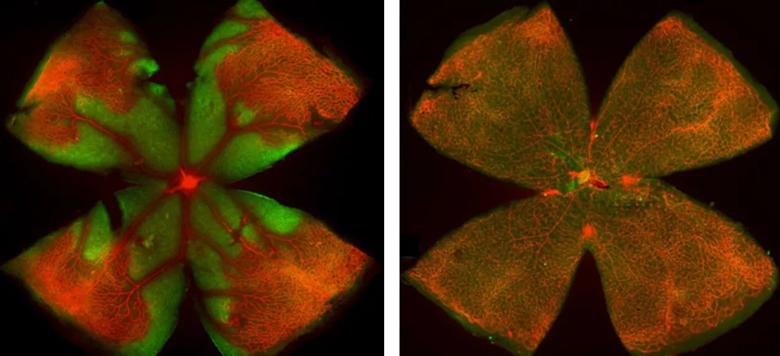
Figure 1. Fluorescent images of retinal flatmounts produced from littermate pups in the mouse oxygen retinopathy model. Isolectin counter staining of blood vessels and Hypoxyprobe fluorescence compares control (left panel) to treated animal (right panel). There is robust protection by systemic hypoxia inducible factor stabilization definitively demonstrated by preservation of retinal blood vessels (red) and reduction of immunofluorescence associated with hypoxic tissue (green).
Extensive analyses of animal models have revealed some surprising conclusions. First, certain small molecules target the fetal liver alone to induce it to remotely protect the eye (schema, Figure 2).7 Second, other small molecules are stable enough to reach the eye when administered either subcutaneously or intraperitoneally. And third, cells in the retina protect themselves against hyperoxia by shifting their metabolism to glycolysis instead of oxidative phosphorylation even in the presence of excess oxygen.
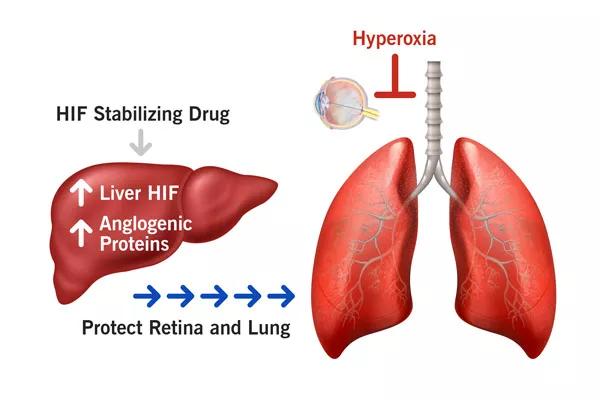
Figure 2. The fetal liver can be induced to remotely protect the retina and lung. The promise of a systemic therapy for Retinopathy of Prematurity lies in simultaneous protection of multiple organs from oxygen toxicity. The molecular and cellular basis of this protection will help develop a new frontier of directing the coordinated and normal growth of blood vessels to prevent ischemia induced pathologic neovascularization and possibly re-vascularize ischemic tissues.
The simplicity of targeting both a central visceral organ and peripheral capillary bed might justify angioprotection in diseases that require only a brief open window for therapy, such as ROP and BPD. The synergy between these two targets facilitates the use of low dose, intermittent therapy. We envision intravenous, soluble small molecules, administered one to two times a week in the first few weeks of life until corrected gestational age of 30 weeks, to gently induce the normal coordinated growth of retinal blood vessels and possibly other organ systems negatively impacted by hyperoxia. In this way, directing normal vascular growth prevents ischemia which is the substrate for disease.
Dr. Sears is a staff member in the Cole Eye Institute.
Additional references are available by contacting Dr. Sears at searsj@ccf.org.
Work discussed here is funded by Research to Prevent Blindness, the E. Matilda Ziegler Foundation for the Blind (J.E.S.), the Hartwell Foundation (J.E.S.) and the National Eye Institute (RO1EY024972) (J.E.S.).
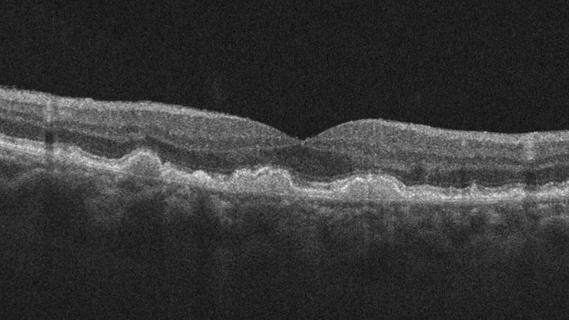
Early data shows risk is 73% higher in patients with lupus, 40% higher in patients with rheumatoid arthritis
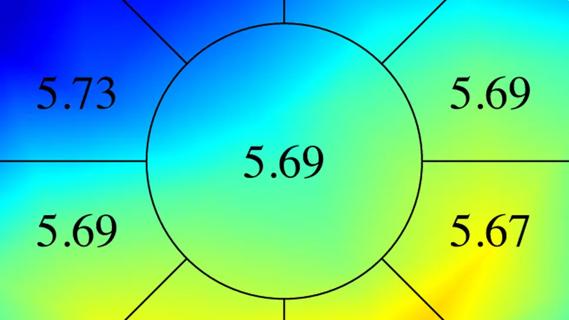
Identifies weak spots in the cornea before shape change occurs

Researchers to study retinal regeneration in zebrafish with new grant from National Eye Institute

30% of references generated by ChatGPT don’t exist, according to one study
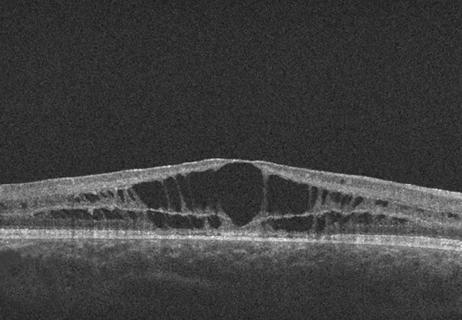
Study followed patients an average of eight years
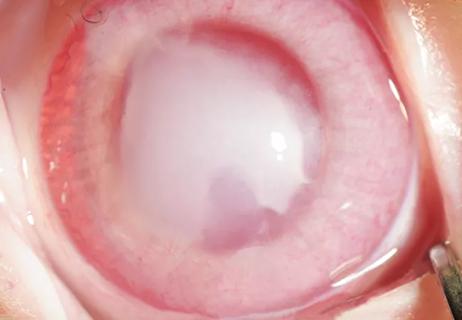
Studies indicate dramatic results when used topically with or without corticosteroids
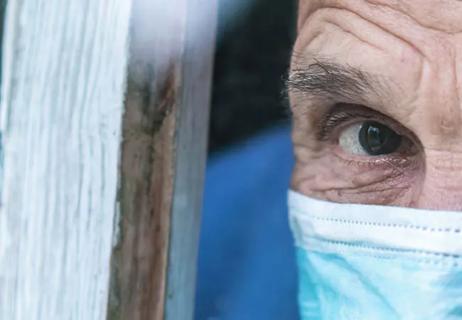
53% of participants didn’t need anti-VEGF for six months or longer
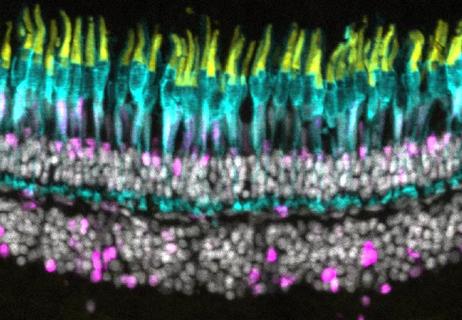
Notch pathway inhibition preserves retinal neurons and promotes regrowth in zebrafish